Brother PC-8200 Owner's Manual
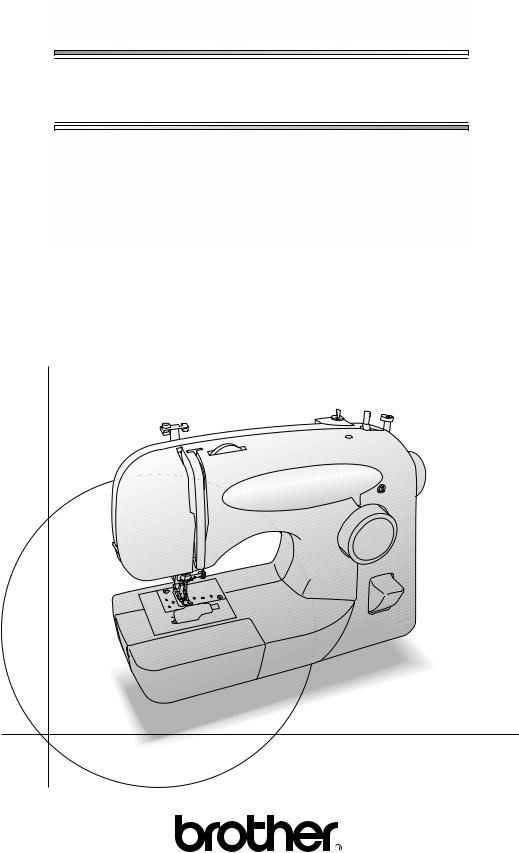
OperationManual

IMPORTANT SAFETY INSTRUCTIONS
When using this machine, basic safety precautions should always be taken, including the following: Read all instructions before using.
DANGER - To reduce the risk of electric shock:
1.The machine should never be left unattended while plugged in. Always unplug the machine from the electrical outlet immediately after using and before cleaning.
2.Always unplug the machine before you change the light bulb. Replace the bulb with same type rated 15 watts.
WARNING - To reduce the risk of burns, fire, electric shock, or injury to persons:
1.Do not allow this machine to be used as a toy. Close attention is necessary when the machine is used by or near children.
2.Use this machine only for its intended use as described in this manual. Use only accessories recommended by the manufacturer as contained in this manual.
3.Never operate this machine if it has a damaged cord or plug, if it is not working properly, if it has been dropped or damaged, or dropped into water. Return the machine to the nearest authorized dealer or service center for examination, repair, electrical or mechanical adjustment.
4.Never operate the machine with any air openings blocked. Keep ventilation openings of the machine and foot control free from the accumulation of lint, dust, and loose cloth.
5.Never drop or insert any object into any opening.
6.Do not use outdoors.
7.Do not operate where aerosol (spray) products are being used or where oxygen is being administered.
8.To disconnect, turn the main switch to the symbol “{” position which represents off, then remove plug from outlet.
9.Do not unplug by pulling on the cord. To unplug, grasp the plug, not the cord.
10.Keep fingers away from all moving parts. Special care is required around the machine needle.
11.Always use the proper needle plate. The wrong plate can cause the needle to break.
12.Do not use bent needles.
13.Do not pull or push fabric while stitching. It may deflect the needle causing it to break.
14.Switch the machine to the symbol “{” position to turn it off when making any adjustments in the needle area, such as threading needle, changing needle, threading bobbin, or changing presser foot, and the like.
15.Always unplug the machine from the electrical outlet when removing covers, lubricating, or when making any other user servicing adjustments mentioned in the instruction manual.
16.This sewing machine is not intended for use by young children or infirm persons without supervision.
17.Young children should be supervised to ensure that they do not play with this machine.
SAVE THESE INSTRUCTIONS
This machine is intended for household use.
1
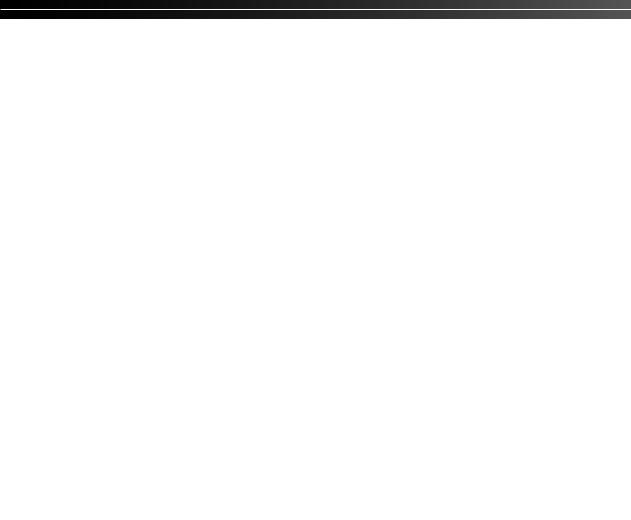
FOR USERS IN THE UK, EIRE, MALTA AND CYPRUS ONLY
If this machine is fitted with a three-pin non-rewireable BS plug then please read the following.
IMPORTANT (in the United Kingdom)
Main supply (AC 230/240V~, 50Hz)
DO NOT cut off the main plug from equipment. If the plug fitted is not suitable for the power point in your home or the cable is too short to reach a power point, then obtain an appropriate safety approved extension lead or consult your dealer.
BE SURE to replace the fuse only with an identical approved type, as originally fitted and to replace the fuse cover.
If none the less the main plug is cut off be sure to remove the fuse and dispose of the plug immediately, to avoid a possible shock hazard by inadvertent connection to the main supply.
IMPORTANT (in the other countries)
If the available socket outlet is not suitable for the plug supplied with this equipment, it should be cut off and an appropriate three pin plug fitted. With alternative plugs an approved fuse must be fitted in the plug.
NOTE: The plug severed from the main leads must be destroyed as a plug with bared flexible cords is hazardous if engaged in a live socket outlet. In the event of replacing the plug fuse, use a fuse approved by ASTA to BS 1362, i.e. carrying the  mark, rating as marked on plug.
mark, rating as marked on plug.
Always replace the fuse cover. Never use plugs with the fuse cover omitted.
WARNING: DO NOT CONNECT EITHER WIRE TO THE EARTH TERMINAL WHICH IS MARKED WITH THE LETTER ‘E’, BY THE EARTH SYMBOL OR COLORED GREEN OR GREEN AND YELLOW.
The wires in this main lead are colored in accordance with the following code:
Blue Neutral
Brown Live
As the colors of the wiring in the main lead of this appliance may not correspond with the colored markings identifying the terminals in your plug, proceed as follows:
The wire which is colored blue must be connected to the terminal which is marked with the letter ‘N’ or colored black or blue.
The wire which is colored brown must be connected to the terminal which is marked with the letter ‘L’ or colored red or brown.
2

UNPACKING INSTRUCTIONS
Keep the carton and packing materials. You may have to take or send the machine to be repaired. If you do not pack it properly, or do not use the right packing material, the machine could be damaged.
Please follow the diagram below to unpack the machine.
IMPORTANT
●This packing material is designed to prevent damage. Save this packing material if you need to take or send this machine to be repaired.
3

PLEASE READ THESE INSTRUCTIONS BEFORE YOU USE THE MACHINE.
To use the machine safely
1.Make sure you watch the needle carefully while you are sewing. Do not touch the balance wheel, thread take-up lever, needle, or other moving parts.
2.Remember to turn off the power switch and unplug the cord:
•when you have stopped using the machine;
•when you are replacing or removing the needle or any other part;
•if there is a power failure while you are using the machine;
•if you are checking or cleaning the machine.
3. Do not store anything on the foot controller.
To give your machine a longer life
1.Do not store this machine in direct sunlight or in high humidity conditions. Do not use or store the machine near a heater, iron, halogen lamp or other hot objects.
2.Use only mild soaps or detergents to clean the case. Benzene, thinner, and scouring powders can damage the case and machine, and should never be used.
3.Do not drop or hit the machine.
4.Always check the operation manual before you replace or fit the presser feet, the needle, or any other parts to make sure you fit them correctly.
To repair or adjust the machine
If the machine breaks down, or you need to adjust it, first follow the troubleshooting table in the Appendix of this operation manual to inspect and adjust the machine yourself. If the problem is still there, please consult your local authorized dealer.
4

CONTENTS |
|
IMPORTANT SAFETY INSTRUCTIONS ............................................................................... |
1 |
UNPACKING INSTRUCTIONS ............................................................................................ |
3 |
CONTENTS ......................................................................................................................... |
5 |
1. KNOWING YOUR SEWING MACHINE .......................................................... |
7 |
THE MAIN PARTS ............................................................................................................... |
8 |
ACCESSORIES ..................................................................................................................... |
9 |
Optional Accessories ........................................................................................................................................ |
9 |
USING YOUR SEWING MACHINE ................................................................................... |
10 |
Connecting Plugs ............................................................................................................................................ |
10 |
Main Power and Sewing Light Switch ............................................................................................................. |
11 |
Foot Controller ................................................................................................................................................ |
11 |
Checking the Needle ....................................................................................................................................... |
11 |
Replacing the Needle ...................................................................................................................................... |
12 |
Changing the Presser Foot ............................................................................................................................... |
13 |
Flat-Bed Attachment ........................................................................................................................................ |
14 |
THE CONTROLS ............................................................................................................... |
15 |
Pattern Selection Dial ...................................................................................................................................... |
15 |
Patterns and Stitch Names ............................................................................................................................... |
16 |
Reverse Sewing Lever ...................................................................................................................................... |
17 |
Using a Free-arm Style .................................................................................................................................... |
17 |
THREADING THE MACHINE ............................................................................................ |
18 |
Winding the Bobbin ........................................................................................................................................ |
18 |
Lower Threading ............................................................................................................................................. |
20 |
Lower Threading (For One-touch lower threading) .......................................................................................... |
21 |
Upper Threading ............................................................................................................................................. |
23 |
Using the Needle Threader (Models equipped with a needle threader) ............................................................ |
24 |
Drawing up the lower thread .......................................................................................................................... |
26 |
Sewing with a Twin Needle ............................................................................................................................ |
27 |
Tension of the Thread ..................................................................................................................................... |
28 |
FABRIC,THREAD,AND NEEDLE COMBINATIONS ........................................................... |
29 |
2. STRAIGHT AND ZIGZAG STITCHING ......................................................... |
31 |
Please Read Before Sewing ............................................................................................................................. |
32 |
Straight Stitching ............................................................................................................................................. |
32 |
Zigzag Stitching .............................................................................................................................................. |
34 |
3. BUILT-IN STITCHES ...................................................................................... |
35 |
Blind Hem Stitching ........................................................................................................................................ |
36 |
Elastic Stitching ............................................................................................................................................... |
36 |
Overedge Stitching .......................................................................................................................................... |
37 |
4. SEWING BUTTONHOLES AND BUTTONS .................................................. |
39 |
Making a Buttonhole ....................................................................................................................................... |
40 |
Adjusting Buttonholes ..................................................................................................................................... |
41 |
Sewing Buttons ............................................................................................................................................... |
42 |
5
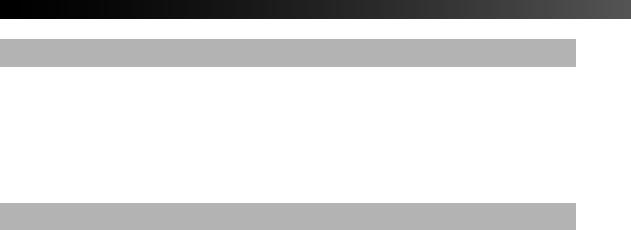
——————————————————————————————————————————————————————————
5. USING ATTACHMENTS AND APPLICATIONS ............................................. |
43 |
Zipper Insertion ............................................................................................................................................... |
44 |
Gathering ........................................................................................................................................................ |
45 |
Darning ........................................................................................................................................................... |
45 |
Appliqués ........................................................................................................................................................ |
46 |
Monogramming and Embroidering ................................................................................................................. |
47 |
OPTIONAL ACCESSORIES ................................................................................................ |
49 |
Using the Walking Foot ................................................................................................................................... |
49 |
Using the Quilting Foot ................................................................................................................................... |
50 |
Using the 1/4-Inch Quilting Foot ..................................................................................................................... |
51 |
6. APPENDIX ..................................................................................................... |
53 |
MAINTENANCE ................................................................................................................ |
54 |
Changing the Light Bulb .................................................................................................................................. |
54 |
Cleaning ......................................................................................................................................................... |
55 |
Troubleshooting .............................................................................................................................................. |
57 |
Repacking the Machine ................................................................................................................................... |
60 |
INDEX ............................................................................................................................... |
61 |
6

1 KNOWING YOUR SEWING MACHINE
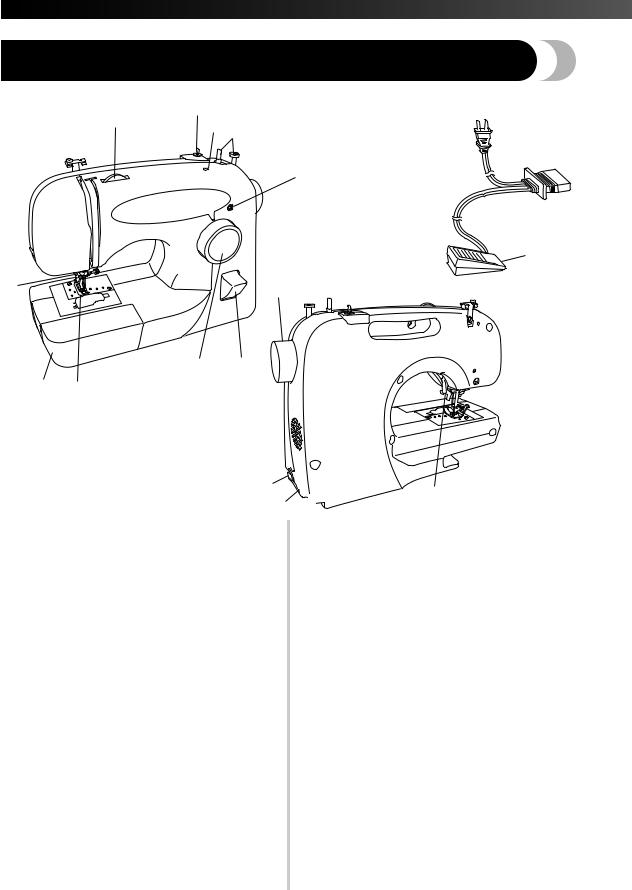
KNOWING YOUR SEWING MACHINE —————————————————————————————————————————
THE MAIN PARTS
4 |
2 |
|
31 |
||
|
0
E
5 |
A |
|
8 9
6 7
B  D
D
C
1Bobbin winder (Page 18)
This winds the thread onto the bobbin,which you use for the lower thread.
2 Spool pin (Page 18, 23)
3Hole for vertical spool pin (Page 27)
This holds a second spool of thread, if you want to sew with two needles.
4Upper tension-control dial (Page 28)
This controls the tension of the upper thread.
5Needle threader (Page 24)
This is only available on certain models.
6Flat bed attachment with accessory compartment (Page 14, 17)
7 Zigzag presser foot (Page 8, 13)
8Pattern selection dial (Page 15)
You can turn this in either direction to choose the stitch you want.
9Reverse-sewing lever (Page 17)
You can push this to stitch in the reverse direction.
0 Buttonhole fine-adjustment screw (Page 34, 41)
A Balance wheel
BMain power and sewing light switch (Page 11)
You can turn the main power and sewing light switch on and off.
CFoot controller jack (Page 10)
Plug in the foot controller plug and connect the machine to the power supply.
D Presser foot lever (Page 23)
EFoot controller (Page 11)
You can use this to control the sewing speed, and to start and stop sewing.
Parts Code for Zigzag Presser Foot: XC4901-051
Foot Controller: Model N
Parts Code: XC5458-021 (110/120V Area)
XC5454-021 (220/240V Area)
XC5462-021 (U.K.)
XC5493-021 (Australia, New Zealand)
XC5494-021 (Argentina)
XC5495-021 (110/220V Dual Area)
8

ACCESSORIES
The following accessories are stored in the flat-bed attachment. We have designed these accessories to help you
carry out most sewing tasks. |
|
|
1 |
||
|
|
|
|
||
|
|
|
|
|
|
1. |
2. |
3. |
4. |
5. |
|
6. |
7. |
8. |
9. |
No. |
Part Name |
|
Part Code |
|
No. |
Part Name |
|
|
Part Code |
|||
USA |
|
Others |
|
|
USA |
|
Others |
|||||
|
|
|
|
|
|
|
|
|||||
1 |
Zipper foot (1 pc.) |
X59370-051 |
5 |
Buttonhole Foot (1 pc.) |
X59369-251 |
|||||||
2 |
Bobbin (3 pcs.) |
SA156 |
SFB |
6 |
Button Sewing Foot (1 pc.) |
X59375-051 |
||||||
(XA5539-151) |
7 |
Extra Spool Pin (1 pc.) |
130920-021 |
|||||||||
|
|
|
|
|||||||||
3 |
Needle Pack (Regular Single |
129583-001 |
8 |
Screwdriver (1 pc.) |
X55467-051 |
|||||||
Needle HAX130 (3 pcs.)) |
||||||||||||
|
|
|
|
|
|
|
|
|
|
|
||
4 |
Twin Needle (1 pc.) |
X57521-001 |
9 |
Darning Plate (1pc.) |
XC6063-021 |
|||||||
Optional Accessories
1. 2. 3.
No. |
Part Name |
Part Code |
||
U.S.A. |
Others |
|||
|
|
|||
1 |
Walking Foot |
SA107 |
F034N |
|
(XC2165-002) |
||||
2 |
Quilting Foot |
SA129 |
F005N |
|
(XC1948-002) |
||||
3 |
1/4-Inch Quilting Foot |
SA125 |
F001N |
|
(XC1944-002) |
||||
 Note
Note
●The accessories that come with your machine depend on which model you have bought.
9

KNOWING YOUR SEWING MACHINE —————————————————————————————————————————
USING YOUR SEWING MACHINE

 WARNING
WARNING
●Use only regular mains household electricity for the power source. Using other power sources may result in fire, electric shock, or damage to the machine.
●Turn off the main power and remove the plug in the following circumstances:
•When you are away from the machine
•After using the machine
•When the power fails during use
•When the machine does not operate correctly due to a bad connection or a disconnection
•During electrical storms

 CAUTION
CAUTION
●Do not use extension cords or multi-plug adapters with many other appliances plugged in to them. Fire or electric shock may result.
●Do not touch the plug with wet hands. Electric shock may result.
●When unplugging the machine, always turn off the main power first. Always grasp the plug to remove it from the outlet. Pulling on the cord may damage the cord, or lead to fire or electric shock.
●Do not allow the power cord to be cut, damaged, modified, forcefully bent, pulled, twisted, or bundled. Do not place heavy objects on the cord. Do not subject the cord to heat. These things may damage the cord and cause fire or electric shock. If the cord or plug is damaged, take the machine to your authorized dealer for repairs before continuing use.
●Unplug the power cord if the machine is not to be used for a long period of time. Otherwise a fire may result.
Connecting Plugs
1Connect the power cord plug into the machine.
2Connectoutlet. the power supply plug into a wall
 Note
Note
●When leaving the machine unattended, the main switch of the machine should be switched off or the plug must be removed from the socket-outlet.
●When servicing the machine, or when removing covers or changing bulbs, the
machine must be unplugged. (For U.S.A. only)
●This appliance has a polarized plug (one blade wider than the other). To reduce the risk of electric shock, this plug is intended to fit in a polarized outlet only one way. If the plug does not fit fully in the outlet, reverse the plug.
If it still does not fit, contact a qualified electrician to install the proper outlet. Do not modify the plug in any way.
10

Main Power and Sewing
Light Switch
This switch turns the mains power and sewing light on or off.
1 Turn on (toward the ‘I’ mark)
2 Turn off (toward the ‘O’ mark)
1

2

Foot Controller
When you press the foot controller down lightly, the machine will run at a low speed. When you press harder, the machine’s speed will increase. When you take your foot off the foot controller, the machine will stop. You should make sure that nothing is placed on the foot controller when the machine is not in use.
1
1 Foot controller

 CAUTION
CAUTION
●Do not allow pieces of cloth and dust to build up on the foot controller. Doing so could cause a fire or an electric shock.
 Note
Note
(For U.S.A. only)
●Foot Controller: Model N
This foot controller can be used for Model XL-2121, XL-2125, XL-2230.
.
Checking the Needle
The sewing needle must always be straight and sharp for smooth sewing.
1
■To Check the Needle Correctly:
Put the flat side of the needle on a flat surface. Check the needle from the top and the sides. Dispose of any bent needles safely.

 1 2
1 2
1 Parallel space
2 Level surface (bobbin cover, glass, etc.)
11
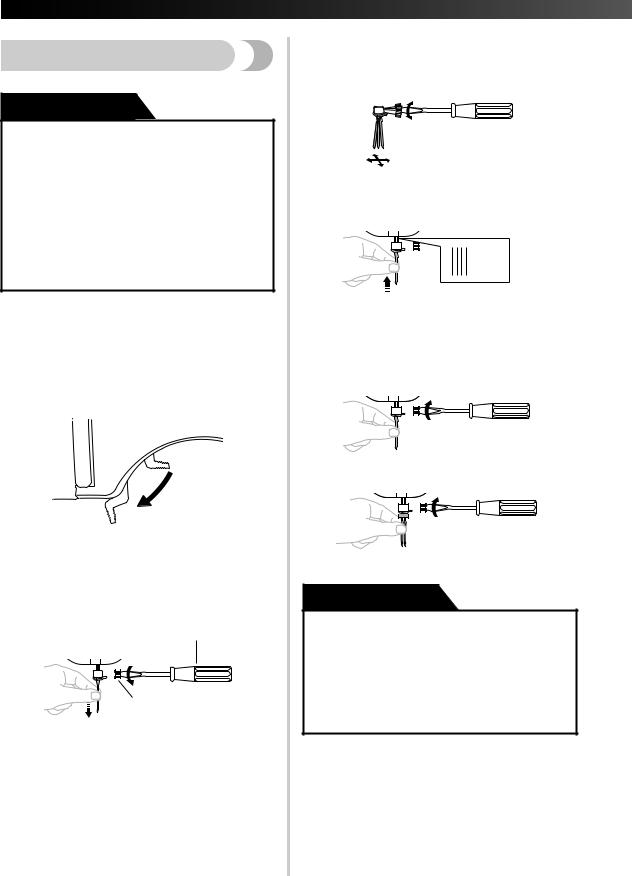
KNOWING YOUR SEWING MACHINE —————————————————————————————————————————
Replacing the Needle

 CAUTION
CAUTION
●Turn the main power switch off before you change the needle. If you leave the main power on and step on the foot controller, the machine will start and you may be injured.
●Only use sewing-machine needles for home use. Other needles may bend or break and cause injury.
●Never sew with a bent needle. A bent needle will easily break and cause injury.
1Removeoutlet. the power supply plug from the
2Raise the needle bar to its highest position by turning the balance wheel counterclockwise.
3Lower the presser foot lever.
1 Presser foot lever
4Hold the needle with your left hand, and then use a screwdriver to turn the needle clamp screw counterclockwise to remove the needle.
1
2
1 Screwdriver
2 Needle clamp screw
•Do not use a lot of force when loosening or tightening the needle clamp screw, otherwise certain parts of the sewing machine may be damaged.
5With the flat side of the needle toward the back of the machine, put the needle in until it touches the needle stopper.
 1
1  2
2
1 Needle stopper
2 Needle
6While holding the needle with your left hand, use the screwdriver to tighten the needle clamp by turning it clockwise.
Put the twin needle in the same way.

 CAUTION
CAUTION
●Make sure you push in the needle until it touches the stopper, and securely tighten the needle clamp screw with a screwdriver. If the needle is not in fully, or if the needle clamp screw is loose, the needle may break or the machine may be damaged.
12
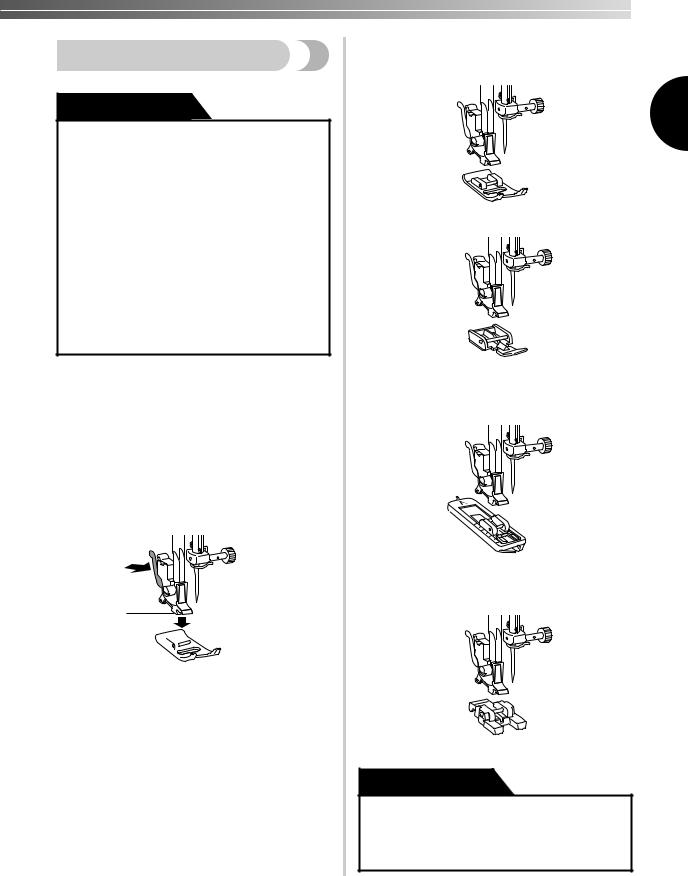
Changing the Presser Foot

 CAUTION
CAUTION
●Always turn off the power before you change the presser foot. If you leave the power on and step on the controller, the machine will start and you may be injured.
●Always use the correct presser foot for the stitch pattern you have chosen. If you use the wrong presser foot, the needle may strike the presser foot and bend or break, and may cause injury.
●Only use presser feet that have been designed to be used with this machine. Using other any presser feet may cause an accident or injury.
You will have to change the presser foot depending on what you want to sew and how.
■ Snap-On Type
1Raise the needle to its highest position by turning the balance wheel toward you (counterclockwise) and raise the presser foot lever.
2Release the foot by raising the lever at the back of the holder.
2
1


1 Presser Foot
2 Shank
3Put a different presser foot on the needle plate so that the bar on the presser foot is in line with the slot on the shank.
4Lower the presser foot lever and fix the presser foot onto the shank. If the presser foot is in the correct place, the bar should snap in.
1
■ Presser foot installation orientation

 CAUTION
CAUTION
●If the presser foot is not installed with the correct orientation, the needle may strike the presser foot, which may bend or break the needle and cause injury.
13

KNOWING YOUR SEWING MACHINE —————————————————————————————————————————
Flat-Bed Attachment
The accessories are stored in a compartment inside the flat-bed attachment.
1Slide the flat-bed attachment to the left to open it.
1 |
1
2
1 Flat-bed attachment
2 Storage compartment
 Note
Note
●Put the accessories inside a bag, and then store the bag inside the compartment. If the accessories are not in a bag, they may fall out, and be lost or damaged.
14

THE CONTROLS
Pattern Selection Dial
 Note
Note
●When you use the Pattern Selection Dial to choose a pattern, turn the balance wheel to the front (counterclockwise) to set the needle in the highest position. If the needle is in the down position when you turn the pattern selection dial, the needle, presser foot or fabric may be damaged.
■ 11 stitches
1 2 3 4 5
To choose a stitch, simply turn the pattern selection |
1 |
|
|
dial in either direction. Stitch widths and lengths are |
|
shown on the following page. |
|
2
1
1 Pattern selection dial
2 Chosen pattern number
6 7 8 9 10 11
■ 8 stitches
1 |
|
2 |
3 |
4 |
5 |
6 |
7 |
8 |
||||
|
|
|
|
|
|
|
|
|
|
|
|
|
|
|
|
|
|
|
|
|
|
|
|
|
|
|
|
|
|
|
|
|
|
|
|
|
|
|
|
|
|
|
|
|
|
|
|
|
|
|
|
|
|
|
|
|
|
|
|
|
|
|
|
|
|
|
|
|
|
|
|
|
|
|
|
|
|
|
|
|
|
|
|
|
|
|
|
|
|
|
|
|
|
|
|
|
|
|
|
|
|
|
|
15

KNOWING YOUR SEWING MACHINE —————————————————————————————————————————
Patterns and Stitch Names
11 stitches
Pattern |
Stitch Name |
Stitch Width |
Stitch Length |
Twin |
Instruction |
|||||||
[mm(inch)] |
[mm(inch)] |
Needle |
Manual Page |
|||||||||
|
|
|
|
|
|
|
|
|||||
1 |
|
|
|
|
|
|
FOUR-STEP AUTOMATIC |
5.0 |
0.5 |
No |
40 |
|
|
|
|
|
|
|
|
BUTTONHOLE |
(3/16) |
(1/32) |
|||
|
|
|
|
|
|
|
|
|
||||
|
|
|
|
|
|
|
|
|
|
|
|
|
|
|
|
|
|
|
|
|
|
|
|
|
|
2 |
|
|
|
|
|
|
STRAIGHT STITCH |
- |
2.5 |
Yes |
32, 44, 45 |
|
|
|
|
|
|
|
|
||||||
|
|
|
|
|
|
|
(Center Needle Position) |
(3/32) |
||||
|
|
|
|
|
|
|
||||||
|
|
|
|
|
|
|
|
|
|
|||
|
|
|
|
|
|
|
|
|
|
|||
|
|
|
|
|
|
|
|
|
|
|
|
|
3 |
|
|
|
|
|
|
STRAIGHT STITCH |
- |
4.0 |
Yes |
32, 45 |
|
|
|
|
|
|
|
|
||||||
|
|
|
|
|
|
|
(Center Needle Position) |
(3/16) |
||||
|
|
|
|
|
|
|
||||||
|
|
|
|
|
|
|
|
|
|
|||
|
|
|
|
|
|
|
|
|
|
|
|
|
4 |
|
|
|
|
|
|
STRAIGHT STITCH |
- |
2.5 |
No |
32, 45 |
|
|
|
|
|
|
|
|
||||||
|
|
|
|
|
|
|
(Left Needle Position) |
(3/32) |
||||
|
|
|
|
|
|
|
||||||
|
|
|
|
|
|
|
|
|
|
|||
|
|
|
|
|
|
|
|
|
|
|||
|
|
|
|
|
|
|
|
|
|
|
|
|
5 |
|
|
|
|
|
|
TRIPLE STRETCH STITCH |
- |
2.5 |
No |
32 |
|
|
|
|
|
|
||||||||
|
|
|
|
|
|
|
(3/32) |
|||||
|
|
|
|
|
|
|
||||||
|
|
|
|
|
|
|
|
|
|
|
||
|
|
|
|
|
|
|
|
|
|
|
||
|
|
|
|
|
|
|
|
|
|
|
|
|
6 |
|
|
|
|
|
|
ELASTIC OVERLOCK |
5.0 |
2.5 |
No |
37 |
|
|
|
|
|
|
|
|
STITCH |
(3/16) |
(3/32) |
|||
|
|
|
|
|
|
|
|
|
||||
|
|
|
|
|
|
|
|
|
|
|
|
|
7 |
|
|
|
|
|
|
ZIGZAG STITCH |
3.0 |
1.5 |
Yes |
34, 42, 46, 47 |
|
|
|
|
|
|
|
|
(1/8) |
(1/16) |
||||
|
|
|
|
|
|
|
|
|
|
|||
|
|
|
|
|
|
|
|
|
|
|
|
|
8 |
|
|
|
|
|
|
ZIGZAG STITCH |
5.0 |
2.0 |
No |
34, 42, 46, 47 |
|
|
|
|
|
|
|
|
(3/16) |
(1/16) |
||||
|
|
|
|
|
|
|
|
|
|
|||
|
|
|
|
|
|
|
|
|
|
|
|
|
9 |
|
|
|
|
|
|
ZIGZAG (SATIN) STITCH |
5.0 |
0.5 |
No |
34, 42, 46, 47 |
|
|
|
|
|
|
|
|
||||||
|
|
|
|
|
|
|
(3/16) |
(1/32) |
||||
|
|
|
|
|
|
|
|
|
|
|||
|
|
|
|
|
|
|
|
|
|
|
|
|
10 |
|
|
|
|
|
|
BLIND HEM STITCH |
5.0 |
2.0 |
No |
36 |
|
|
|
|
|
|
|
|
(3/16) |
(1/16) |
||||
|
|
|
|
|
|
|
|
|
|
|||
|
|
|
|
|
|
|
|
|
|
|
|
|
11 |
|
|
|
|
|
|
ELASTIC STITCH |
5.0 |
1.0 |
No |
36 |
|
|
|
|
|
|
|
|
(3/16) |
(1/16) |
||||
|
|
|
|
|
|
|
|
|
|
|||
|
|
|
|
|
|
|
|
|
|
|
|
|
8 stitches |
|
|
|
|
|
|||||||
|
|
|
|
|
|
|
|
|
|
|
|
|
Pattern |
Stitch Name |
Stitch Width |
Stitch Length |
Twin |
Instruction |
|||||||
[mm(inch)] |
[mm(inch)] |
Needle |
Manual Page |
|||||||||
|
|
|
|
|
|
|
|
|||||
1 |
|
|
|
|
|
|
FOUR-STEP AUTOMATIC |
5.0 |
0.5 |
No |
40 |
|
|
|
|
|
|
|
|
||||||
|
|
|
|
|
|
|
BUTTONHOLE |
(3/16) |
(1/32) |
|||
|
|
|
|
|
|
|
|
|
||||
|
|
|
|
|
|
|
|
|
|
|
|
|
2 |
|
|
|
|
|
|
STRAIGHT STITCH |
- |
2.5 |
Yes |
32, 44, 45 |
|
|
|
|
|
|
|
|
||||||
|
|
|
|
|
|
|
(Center Needle Position) |
(3/32) |
||||
|
|
|
|
|
|
|
||||||
|
|
|
|
|
|
|
|
|
|
|||
|
|
|
|
|
|
|
|
|
|
|||
|
|
|
|
|
|
|
|
|
|
|
|
|
3 |
|
|
|
|
|
|
STRAIGHT STITCH |
- |
4.0 |
Yes |
32, 45 |
|
|
|
|
|
|
|
|
||||||
|
|
|
|
|
|
|
(Center Needle Position) |
(3/16) |
||||
|
|
|
|
|
|
|
|
|
|
|||
|
|
|
|
|
|
|
|
|
|
|||
|
|
|
|
|
|
|
|
|
|
|
|
|
4 |
|
|
|
|
|
|
STRAIGHT STITCH |
- |
2.5 |
No |
32, 45 |
|
|
|
|
|
|
|
|
||||||
|
|
|
|
|
|
|
(Left Needle Position) |
(3/32) |
||||
|
|
|
|
|
|
|
||||||
|
|
|
|
|
|
|
|
|
|
|||
|
|
|
|
|
|
|
|
|
|
|||
|
|
|
|
|
|
|
|
|
|
|
|
|
5 |
|
|
|
|
|
|
ZIGZAG STITCH |
3.0 |
1.5 |
Yes |
34, 42, 46, 47 |
|
|
|
|
|
|
|
|
(1/8) |
(1/16) |
||||
|
|
|
|
|
|
|
|
|
|
|||
|
|
|
|
|
|
|
|
|
|
|
|
|
6 |
|
|
|
|
|
|
ZIGZAG STITCH |
5.0 |
2.0 |
No |
34, 42, 46, 47 |
|
|
|
|
|
|
|
|
(3/16) |
(1/16) |
||||
|
|
|
|
|
|
|
|
|
|
|||
|
|
|
|
|
|
|
|
|
|
|
|
|
7 |
|
|
|
|
|
|
ZIGZAG (SATIN) STITCH |
5.0 |
0.5 |
No |
34, 42, 46, 47 |
|
|
|
|
|
|
|
|
||||||
|
|
|
|
|
|
|
(3/16) |
(1/32) |
||||
|
|
|
|
|
|
|
|
|
|
|||
|
|
|
|
|
|
|
|
|
|
|
|
|
8 |
|
|
|
|
|
|
ELASTIC STITCH |
5.0 |
1.0 |
No |
36 |
|
|
|
|
|
|
|
|
(3/16) |
(1/16) |
||||
|
|
|
|
|
|
|
|
|
|
|||
|
|
|
|
|
|
|
|
|
|
|
|
|
16

Reverse Sewing Lever
You can use reverse sewing for back tacking and reinforcing seams.
1
To sew in reverse, push the Reverse Sewing Lever in as far as possible and hold it in that position while you lightly push the foot controller. To sew forward, release the Reverse Sewing Lever. The machine will then sew forward.
1
1 Reverse sewing lever
Using a Free-arm Style
Free-arm sewing is convenient for sewing tubular and hard-to-reach areas. To change your machine to the free-arm style, lift out the flat-bed attachment.
1Slide the flat-bed attachment to the left to release it.
 1
1
1
1 Flat-bed attachment
17
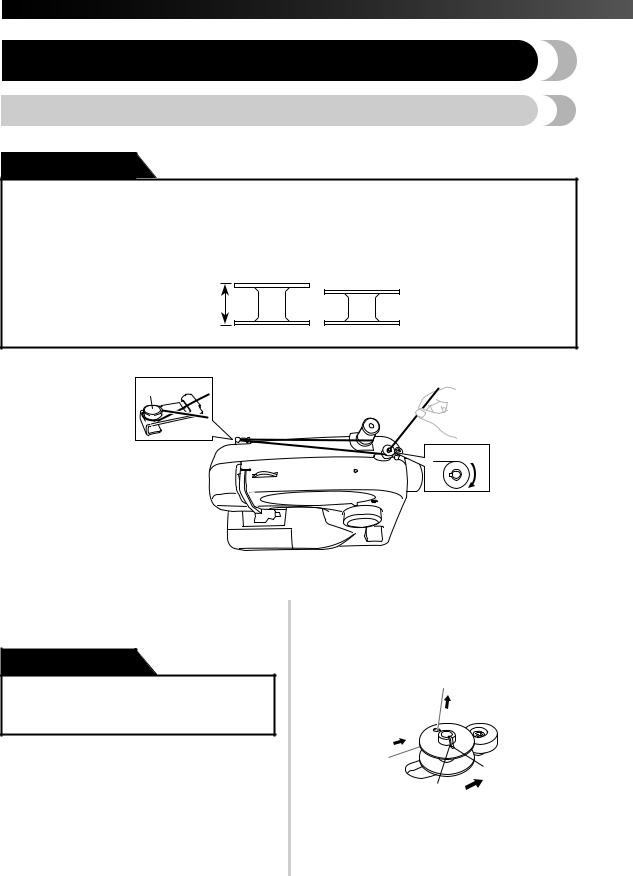
KNOWING YOUR SEWING MACHINE —————————————————————————————————————————
THREADING THE MACHINE
Winding the Bobbin

 CAUTION
CAUTION
●Only use the bobbin (part code: SA156, SFB (XA5539-151)) that has been designed for this sewing machine. Using of any other bobbin may cause damage to the machine.
●We designed the bobbin that comes with this machine. If you use bobbins from older models, the machine will not work properly. Only use the bobbin that comes with this machine or bobbins of the same type (part code: SA156, SFB (XA5539-151)).
Actual size
11.5 mm (7/16 inch)
This model |
Older model |
1
2
1Bobbin-winding tension disc
2Bobbin-winder shaft
1Put the spool of thread on the spool pin and pass the thread around the bobbin-winding tension disc.

 CAUTION
CAUTION
●If the spool of thread is not in the right place, the thread may tangle on the spool pin.
2Pass the end of the thread through the hole on the bobbin from the inside of the bobbin.
3Put the bobbin onto the bobbin-winder shaft and slide the bobbin-winder shaft to the right. Turn the bobbin clockwise, by hand, until the spring on the shaft slides into the groove of the bobbin.
2
1
1 Spring on the shaft
2 Groove of the bobbin
18
